John Ward Westcott
| John Ward Westcott | |
|---|---|
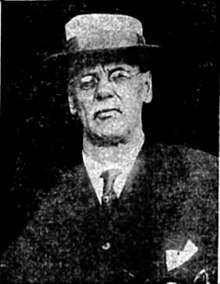 circa 1910 | |
| Born |
December 19, 1848 Lime Island, Michigan |
| Died |
August 17, 1913 (aged 64) Ann Arbor, Michigan |
| Nationality | American |
| Occupation | Businessman |
| Known for | marine technology |
| Notable work | marine mail service |
John Ward Westcott (December 19, 1848 – August 17, 1913) was an American ship captain on the Great Lakes in the late nineteenth and early twentieth century. He is noted for making and developing the first floating range lights for safe navigation in Lake St. Clair at the Detroit River. He developed a mail system between moving Great Lakes freighters, that ultimately led to the only floating United States post office, and enabled United States Mail delivery to ships 'on the fly'.
Early life and education

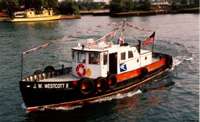
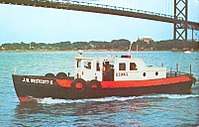
Westcott was born at the village of Warnersville on Lime Island, Michigan, on December 19, 1848. The island is in the St. Mary's river located in the Upper Peninsula of Michigan, next to Ontario, Canada. He was the son of shipbuilder David Westcott and his wife Mary. His father was 25 and his mother was 22 at the time of his birth. He had five brothers and two sisters.[1]
Westcott went to public schools and received a grade school education. At the age of 13, he became a cabin boy on the ship SS Forester. From this job he learned the operations of a ship steamer. Westcott then became a ship captain in 1868 at the age of twenty. When he received this promotion he was the youngest captain on the Great Lakes.[1]
Career
Westcott established the first range lights at Grosse Pointe, Michigan. He also developed the first lightship on Lake St. Clair in Michigan. This he did by buying an old flat-bottomed boat and put a light on it as a guiding light for ships on the lake. They were range lights on Windmill Point as a guiding light to help ships avoid going aground at Belle Isle and Peche Island, a Canadian island in the Detroit River.[2][3][4]
Wescott established a marine reporting firm in 1874. He saw a need for reporting information about ship crew members to family and friends and vice versa. He would meet large vessels in the Detroit River with his row boat to relay messages written on paper. He charged 25 cents per item, a substantially higher fee than the post office was charging for a piece of mail. People didn't mind paying this amount, as it was a needed service that the United States post office was not providing. In addition to communications, the service provided shipping trade information and national-international news.[5]
Westcott's service developed into a mail-in-the-pail technique first done in the Detroit River on June 17, 1895.[6][7][8]
The procedure then was that a man in a rowboat was towed out by the Florence B. power boat to meet an oncoming freighter traveling down the Detroit River. This man then threw a line up to a sailor on the large vessel, who would catch it and secure it to the deck. The man in the rowboat would wait until the slack played out and the tight rope then pulled the rowboat in tow at the same speed as the freighter.[9] The mail was transferred between the vessels by a pail on a rope that was lowered from the large ship to Westcott's rowboat.[9] It was then pulled up back up onto the large ship after the mail was exchanged in the pail.[10] After that the rowboat was released from the towing line of the large freighter, it was then rowed to the next oncoming freighter to do the same procedure. After all the Detroit River traveling freighters with mail were served, the man in the rowboat went back to the Detroit port where he started from earlier in the day.[9]
This was a type of marine mail service to and from moving vessels of through traffic that didn't stop at a Detroit port. The private enterprise grew from 47,000 pieces of mail in its first year of operation. It ultimately led to Westcott's vessel becoming an official United States Postal Service-contracted mail-boat in 1948 as a privately owned floating post office, and by 1972 was accounting for over 700,000 pieces of mail being handled per year.[9][11][12][13][6]
Wescott's service meant that ships didn't have to stop and go ashore to pick up their mail and could get it 'on the fly' while still moving midstream in the Detroit River.[14] He added a power boat in 1908 to meet these larger moving vessels – the SS J.W. Wescott No.1.[15][16] A second boat, the 45 foot (14 m) craft J. W. Westcott II, was introduced to the floating mail service in 1955.[17] It was renewed on a United States Postal Service contract in 1974. The work was done by non-postal employees of the Wescott Company around the clock seven days a week.[18][19][20][21] It led to the only floating post office associated with a zip code in the United States – 48222, the Detroit River Post Office.[6][22][23][24]
The larger vessels and freighters traveling the Detroit River do not stop in general, but are just through traffic to other destinations.[17] Those that want to communicate with the Great Lake freighters send their mail in care of the ship's name at zip code 48222 and it is forwarded accordingly by the Westcott Company.[25] As of 2017, the company gets about a third of its income from the post office, and the remainder is split between other contracts and fares for passenger transport.[13] The company's reserve craft is the Joseph J. Hogan.[8]
Personal life
Westcott married Henrietta Eagles Crane of Newark, New Jersey, on December 29, 1878.[26] They had four children: Mary (born 1880), Henrietta (born 1882), John Westcott II (born 1884), and Charles (born 1890), all born in Detroit.[27]
Westcott died on August 17, 1913, at the age of 64.[28]
Wescott's marine mail system
 Mail steamer meeting traffic
Mail steamer meeting traffic
in the Detroit River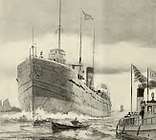 Mail carrier preparing matching speed
Mail carrier preparing matching speed
to larger freighter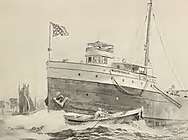 Riding bow wave
Riding bow wave
to catch delivery bucket Delivering mail in a pail
Delivering mail in a pail
that is hoisted up by sailors
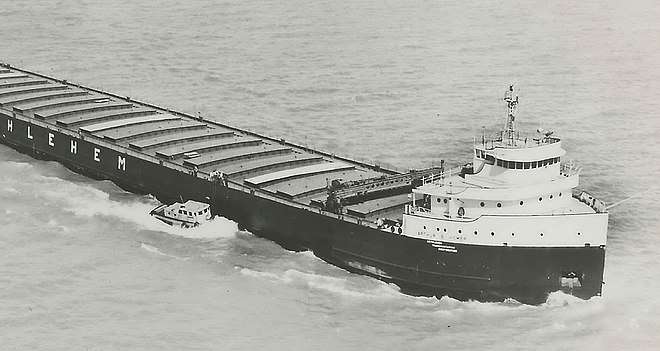
References
- 1 2 Greenwood 1986, p. 483.
- ↑ NSC 1966, p. 57.
- ↑ LCA 1913, p. 189.
- ↑ Bailey 1979, p. 5.
- ↑ Keefe 1998, p. 285.
- 1 2 3 "Mail-In-The-Pail Service Begins Its 75th Year". The Indiana Gazette. Indiana, Pennsylvania. June 17, 1970. p. 27 – via newspapers.com

- ↑ "Neither Fog, Nor Waves". The Post-Crescent. Appleton, Wisconsin. June 17, 1970. p. 1 – via newspapers.com

- 1 2 Maynard, Brent. "The J.W. Westcott Company". Detroit Historical Society. Retrieved July 6, 2017.
- 1 2 3 4 "Marine mail operations serves crewmen". Neosho Daily News. Neosho, Missouri. August 21, 1974. p. 15 – via newspapers.com

- ↑ Brown 2011, p. 298.
- ↑ "Code 48222 Zipshape On River Ship". Santa Ana Register. Santa Ana, California. December 14, 1975. p. 37 – via newspapers.com

The Westcott company was formed in 1874 by Capt. J. W. Westcott, who saw a need for the service on the river, one of three major crossroads of Great Lakes commercial traffic.
- ↑ Keefe 1998, p. 284.
- 1 2 Kelley, Tyler J. (August 20, 2016). "BUSINESS DAY: A Mail Boat Stays Afloat". New York Times . Retrieved July 6, 2017.
- ↑ "Ships To Get Mail Delivery In Midstream". The Marion Star. Marion, Ohio. March 15, 1973. p. 7 – via newspapers.com

- ↑ "Will Use power Boat / Westcott Marine Reporting Agency Has New River Craft". Detroit Free Press. Detroit, Michigan. August 19, 1908. p. 6 – via newspapers.com

- ↑ Anderson 1953, p. 11.
- 1 2 "Moving Post Office". Lubbock Avalanche-Journal. Lubbock, Texas. July 10, 1955. p. 57 – via newspapers.com

- ↑ "Floating Zip Code Remains Active". News-Journal. Mansfield, Ohio. December 7, 1975. p. 2 – via newspapers.com

The Westcott company was formed in 1874 by Capt. J.W. Westcott, who saw a need for the service on the river, one of three major crossroads of Great Lakes commercial traffic.
- ↑ "Mr. Zip takes to the water on Lake Erie". Journal-News. Hamilton, Ohio. December 9, 1970 – via Newspapers.com

The nation's only floating zip code has a new lease on life. Zip Code 48222, 45 feet long and 13 feet wide, serves ore carriers, tankers and other vessels, plying the Detroit River between Lake Erie and Lake St. Clair. Its name J.W. Wescott II.
- ↑ Keefe 1998, p. 287.
- ↑ Peace 1963, p. 31.
- ↑ Gallagher 2016, p. 311.
- ↑ Grosvenor, Gilbert (1950), "National Geographic Magazine", National Geographic Magazine, New York, xcvii (6), p. 9
- ↑ Wrobleski 2017, p. 76.
- ↑ "Mail Boat Has Own Zip Code". The Progress-Index, p. 14. Petersburg, Virginia. April 16, 1967 – via newspapers.com

- ↑ Bailey 1979, p. 8.
- ↑ Bailey 1979, p. 9.
- ↑ "Died". Detroit Free Press. Detroit, Michigan. August 19, 1913. p. 12 – via newspapers.com

Sources
- Anderson, Willard V. (1953). Ships and the Sea. Kalmbach Publishing Company.
- Bailey, Gary L. (1979). Westcott: The First Hundred Years. Bowling Green State University.
- Brown, Curt (2011). So Terrible a Storm: A Tale of Fury on Lake Superior. Minneapolis, Minnesota: MBI Publishing Company. ISBN 978-1-61060-255-6.
- Gallagher, Winifred (28 June 2016). Post Office Created America. Penguin Publishing Group. ISBN 978-0-399-56403-1.
- Greenwood, John Orville (1986). Namesakes, 1910–1919. Freshwater Press.
- Keefe, William Ford (1 January 1998). Voices from the Sweetwater Seas: A Great Lakes Anthology. Action Research Institute. ISBN 978-0-9635609-8-8.
- LCA, Lake Carriers' Association (1913). Annual Report Lake Carriers'. Lake Carriers' Association.
- NSC, National Safety Congress (U.S.) (1966). National Safety Congress Transactions. National Safety Council.
- Peace, H. L. (1963). The Work Boat. H. L. Peace Publications.
- Wrobleski, Diane G. (22 May 2017). Growing Up In Michigan. Lulu Publishing Services. ISBN 978-1-4834-6743-6.
External links
| Wikimedia Commons has media related to Floating Post Office. |
- Find-A-Grave
- Mail Boat Stays Afloat
- J.W. Westcott Company Timeline
- J.W. Westcott II floating post office
- SIX minute video – J.W Westcott Company deliveries on the Detroit River
- Detroit’s Marine Post Office (includes 5 minute video of mail-in-a-pail transfer technique).